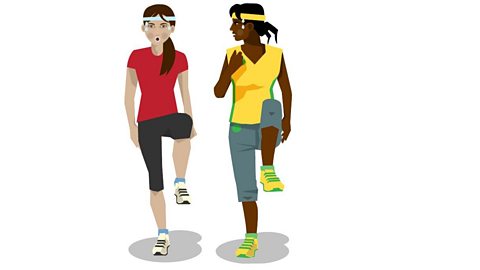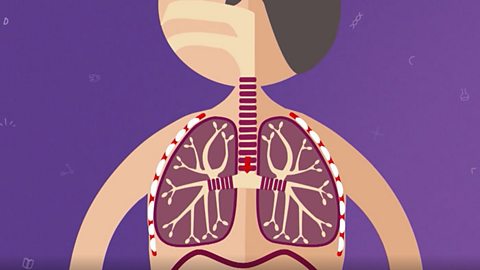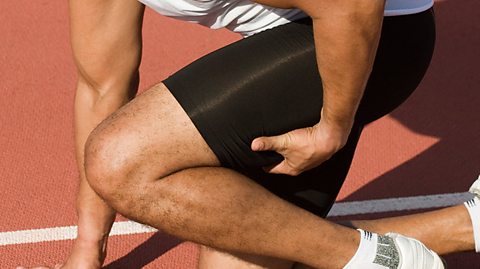Key points
- There are three main gases in air that are taken in and removed from the body. These are oxygen, nitrogen and carbon dioxide.
- Gas exchange is the ‘swapping’ of gasses - absorbing oxygen into the blood and removing carbon dioxide from the blood.
- diffusionThe overall movement of particles of gas or liquid from an area of higher to lower concentration. moves oxygen out of the alveoli and into the blood.
Breathing, respiration and gas exchange

- Inhalation and exhalation is the same as breathing or ventilation and is a physical process which moves air into and out of your lungs.
- Respiration is not the same as breathing, and is a chemical process which occurs in all of your cells.
- Gas exchange is a process that involves the swapping of gases that occurs at exchange surfaces such as the alveoli found within your lungs.

Function of the gas exchange system
Gas exchange allows oxygen to travel into your cells for respiration whilst also removing carbon dioxide, which is a waste substance made by the process of respiration. Respiration is a vital process that involves releasing energy from glucose. All living things do this to stay alive.
Structure of the gas exchange system
The gas exchange system is made from key parts, each of which has a different function.
| Part of the gas exchange system | Function |
|---|---|
| Trachea | This is also called the windpipe. This tube runs from the mouth, down the throat towards the lungs. It is lined with rings of cartilageA tough, flexible material found in the nose and ears, but also between bones in your spine, knees and around your trachea. which keep it open at all times. |
| Bronchus | The trachea splits into a left and right bronchus (plural: bronchi), each leads to a lung. |
| Bronchiole | Each bronchus splits again and again into thousands of smaller tubes called bronchioles which take the air deeper into the lungs. |
| Alveoli | At the ends of bronchioles are tiny air sacs called alveoli. Here oxygen moves into the blood and carbon dioxide moves out. |
| Intercostal muscles | These muscles run between the ribs and form the chest wall. They contract and relax with the diaphragm when a person breathes. |
| Diaphragm | The diaphragm is a dome-shaped, flat sheet of muscle under the lungs. It contracts and relaxes with the intercostal muscles during breathing. |
How does oxygen travel into blood?
Air is breathed into the lungs through the windpipe called the trachea.
The trachea divides into two tubes called the bronchi.
The bronchi divides into many tubes called bronchioles.
The bronchioles divide until they end up in tiny air sacs called alveoli. There are millions of alveoli found within the lungs.
These alveoli are surrounded by a network of capillaries, allowing for oxygen and carbon dioxide to be exchanged between the blood in the capillaries and the air in the lungs. The oxygen molecules are carried in red blood cells.
The exchange of these two gasses occurs by a process called diffusion.
Alveoli
Alveoli are tiny air sacs in the lungs where gas is exchanged during breathing.
Within the human lungs the alveoli provide an efficient exchange surface adapted for gas exchange. This involves the ‘swapping’ of gasses. For example:
Absorbing oxygen, which is needed for respiration, into the blood from the air.
Transferring carbon dioxide, which is produced by respiration, from the blood into the lungs and then the air.
How are the alveoli adapted for gas exchange?
- Alveoli have a very large surface area to enable more diffusion of oxygen into the blood from the alveoli, and more carbon dioxide out of the blood into the alveoli.
- They are only one cell thick so that the diffusion distance is small.
- They have lots of blood capillariesTiny blood vessels which carry blood into and out of all tissues in the body. to ensure a good blood supply to maintain concentration gradients of oxygen and carbon dioxide.
- They have moist surfaces for gases to dissolve in to form a solution to pass through the cell membraneThis surrounds the outside of animal cells and controls what can enter and exit it..
Some water vapour is lost from the surface of the alveoli into the lungs - we can see this condensing when we breathe out on cold days.
Ventilation
Air gets into and out of the body by the physical process of breathing, also called ventilation. This process involves movements of the ribs, intercostal muscles and diaphragm to move air into and out of the lungs.
These are the changes involved during inhalation and exhalation.
| Inhaling | Exhaling | |
|---|---|---|
| Diaphragm | Contracts and moves downwards | Relaxes and moves upwards |
| Intercostal muscles | Contract, moving the ribs upwards and outwards | Relax, letting the ribs move downwards and inwards |
| Volume of ribcage | Increases | Decreases |
| Pressure inside the chest | Decreases below atmospheric pressure | Increases above atmospheric pressure |
| Movement of air | Moves into the lungs | Moves out of the lungs |
Respiration
There are two types of respiration that can occur in your cells:
- Aerobic respiration
- Anaerobic respiration
Test your knowledge
Quiz
Test question
Describe and explain four adaptations of the alveoli that helps the rapid diffusion of oxygen into the blood.
- Alveoli have a very good blood supply. This maintains a concentration gradient between the alveoli and the capillaries.
- Alveoli have very thin walls, one cell thick so the diffusion pathway is very short.
- Alveoli have a large surface area. This allows more space for oxygen molecules to move across from the alveoli to the blood.
- They have moist surfaces. Gases dissolve and form a solution then pass through the cell membrane.
Teaching resources
Need some extra resources to support your biology lessons? In this short film from 91»»±¨ series Inside The Human Body viewers are taken on a journey around the Circulatory system.
91»»±¨ Teach has thousands of free, curriculum-linked resources to help deliver lessons - all arranged by subject and age group.
Play the Atomic Labs game! gamePlay the Atomic Labs game!
Try out practical experiments in this KS3 science game.

More on Respiration and gas exchange
Find out more by working through a topic
- count2 of 13

- count3 of 13

- count4 of 13

- count5 of 13
